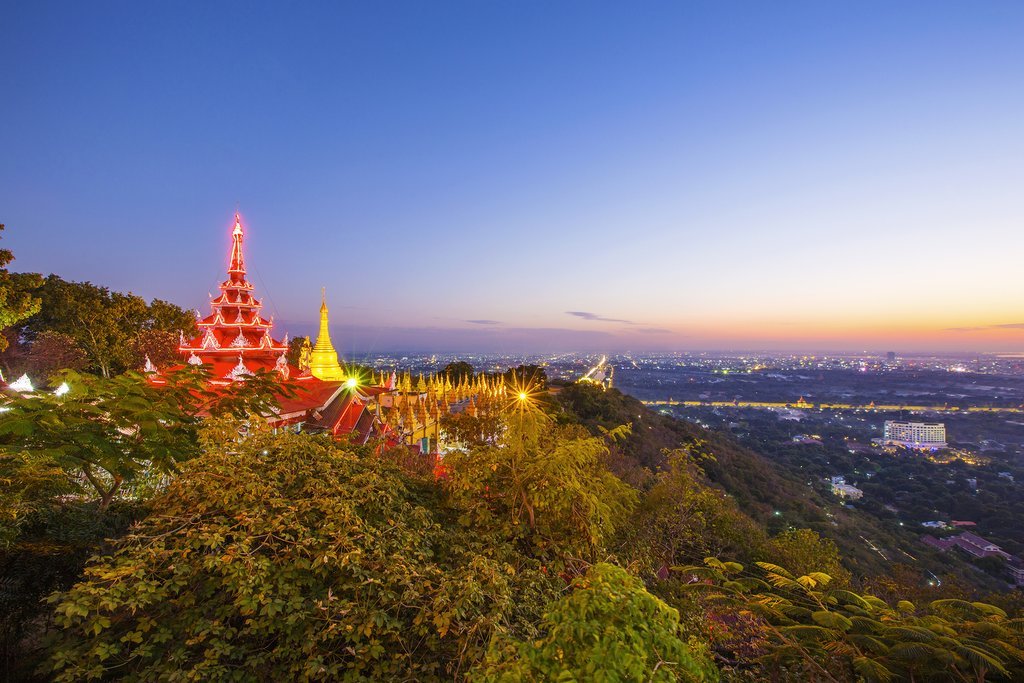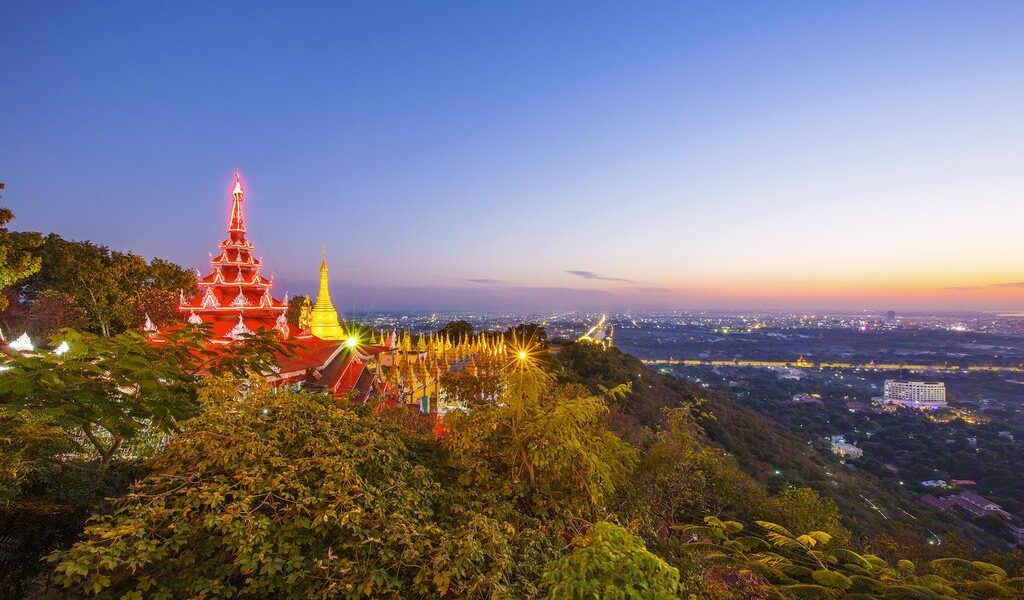
If you don’t mind the rain, July is a wonderful time to visit Myanmar. The big tourist crowds disappear. and in Myanmar’s “Big Four” destinations (Bagan, Mandalay, Inle Lake, and Yangon), you’ll find not only fewer people but also lower prices. The downside, of course, is that aside from August, July is the wettest month of the year. That said, most destinations in the north receive regular breaks of sunshine throughout the day, during which you can wander around comfortably and explore the sites.
**Weather**
July in Myanmar signals the heart of the rainy season, a period of dramatic weather patterns that paint the landscape in vibrant greens. In fact, it stands out as the second wettest month across the nation. Statistically speaking, you can anticipate rainfall on roughly half the days in July. This translates to approximately 15 days experiencing showers or heavier downpours throughout the month, so make sure that you pack accordingly.
The temperature profile in July bears a resemblance to June’s, although there’s a subtle dip in the overall heat. The exact figures will depend greatly on the specific location you choose to visit. In mountainous regions such as the charming town of **Pyin Oo Lwin** or the serene landscapes surrounding **Kalaw**, you can expect temperatures to hover around a comfortable 75 degrees Fahrenheit, offering a welcome respite from the humidity that pervades the rest of the country. Conversely, if your travels take you to the northern-central plains, you’ll find yourself in cities like Mandalay and Bagan. Here, the mercury can climb as high as 93 degrees Fahrenheit, creating a warmer, more tropical feel.
The coastal regions of Myanmar bear the brunt of the monsoon season’s fury. Torrential downpours and powerful winds batter the shorelines, and the roads themselves often fall victim to erosion and washouts. As a result, it’s generally not advisable to include beach destinations in your itinerary during July. The intense weather makes it difficult, and sometimes impossible, to reach these locations. Further inland, flooding becomes a pervasive issue, affecting roads and transportation networks across the country. Given these challenges, opting for air travel emerges as the most convenient and reliable mode of transportation during July. Flying allows you to bypass the flooded roads, avoiding transit delays and ensuring that you can comfortably reach your destination.
It’s also crucial to be aware that July marks a period when dengue fever becomes more prevalent. The increased rainfall leads to the formation of puddles and stagnant water, which serve as breeding grounds for mosquitoes. As such, it’s essential to take precautions to protect yourself from mosquito bites. Carrying and using a high-quality bug spray is highly recommended, and wearing long sleeves and pants, particularly during dawn and dusk, can provide an added layer of defense.
**Crowds and Costs**
The challenging weather conditions in July present a silver lining: a remarkable absence of crowds. The high season tourists have largely departed, leaving the temples, museums, tour buses, and even local restaurants noticeably emptier. This reduction in tourist traffic is especially pronounced among visitors from North America, Europe, and Australia. While you’ll still encounter a number of tourists from China and other Asian countries, along with Burmese locals, the overall volume of visitors is significantly reduced.
The decrease in crowds coincides with a corresponding drop in prices. This is particularly evident in the realm of hotels and lodging. Many establishments offer special “rainy season rates,” making it possible to secure accommodations at a fraction of the cost during peak season. You can also find attractive deals on other aspects of your trip, such as food and organized tour packages.
**Where to Go**
Despite the prevailing rainy season, certain regions of Myanmar offer a more favorable climate during July. The northern tourist cities, particularly Bagan, experience considerably less rainfall than other parts of the country. In fact, Bagan typically boasts an average of 23 dry days in July, meaning that rain falls on only 7 or 8 days of the month. This makes it a truly ideal destination for July, as you can comfortably explore the awe-inspiring archaeological ruins, delve into the region’s rich history, and avoid the intense heat that characterizes other times of the year.
Mandalay also presents a worthwhile option for a July visit. While it’s slightly more susceptible to rainfall than Bagan, with more rainy days and potentially heavier downpours, Mandalay still enjoys its share of dry periods. Mornings are often clear and sunny, with showers tending to arrive later in the afternoons. The mountains and hills surrounding Mandalay, particularly in towns such as Pyin Oo Lwin or Hsipaw, undergo a stunning transformation in July. They become lush and verdant, displaying scenery that far surpasses the dry season’s parched landscapes. If you pack a reliable rain jacket, July is an excellent time for embarking on hikes through these hills, immersing yourself in Myanmar’s breathtaking natural beauty.
Inle Lake is another destination that truly shines during this time of year. The temperature generally hovers around a comfortable 80 degrees Fahrenheit. The mornings over the lake are often misty, with the fog lending a mysterious and surreal atmosphere to the surroundings. While rainfall does occur, sometimes causing road closures (so be sure to check conditions before traveling by car), it’s less frequent than in regions farther south. Furthermore, the sun often emerges between storms, creating opportunities for idyllic boat cruises through the picturesque canals.
If you decide to include Yangon in your itinerary, be prepared for frequent and potentially heavy rain. The southern part of the country experiences the most intense monsoon conditions, and Yangon tends to be consistently wet throughout July. However, this doesn’t mean that you should avoid visiting the city. With proper planning and a reliable raincoat or poncho, you can still have a fulfilling experience. Many of Yangon’s tourist attractions are located indoors, such as temples and museums, providing shelter from the elements. Plus, you’ll be able to explore the city without the usual crowds or the oppressive heat that prevails during the rest of the year.
**What to Do**
July provides an exceptional opportunity to explore the ancient ruins of Bagan without the hordes of tourists or the sweltering heat. Rise early to witness a breathtaking sunrise from one of the many sacred temples. Then, spend your afternoons delving into the various archaeological sites, allowing you to appreciate the history of the region. Be sure to visit the Shwezigon Temple, a landmark that was first conceived under King Anawrahta, the founder of the Pagan Dynasty, and the Ananda Temple, commissioned by his son, King Kyansittha.
In Mandalay, make the ascent up Mandalay Hill, where a stunning viewpoint awaits. This viewpoint is accessible via a Buddhist shrine, reached by climbing 1,729 steps. The stairs are covered, so even if it rains, it’s still a pleasant and rewarding hike. As an added bonus, the weather is generally cooler during this time of year. Outside of Mandalay, visit the striking white Hsinbyume Pagoda, located in the town of Mingun in the Sagaing Region. When you’re ready to leave the city, consider a trip to Pyin Oo Lwin, about 1.5 hours northeast. Its botanical garden flourishes with blooming flora this time of year.
In the mountains surrounding Inle Lake, stop by the gilded Hpaung Daw U Pagoda, which glistens in gold, or the unique Nga Phe Kyaung Monastery. The monastery is where cats live in harmony alongside the monks. In the early evening, take a taxi up the scenic mountainside to the Red Mountain Estate Vineyards to visit the tasting room. Sipping Cabernet Sauvignon while watching the sunset over the valley is a truly mesmerizing experience. The on-site restaurant serves delectable dinners and offers an indoor seating area in case of rain.
**Events in July**
* **Full Moon Day of Waso:** On the full moon day of Waso, the fourth month in the Burmese calendar that usually falls in July, the people of Myanmar celebrate the commencement of the three-month Buddhist Lent. Monks spend more time on meditation and study. Therefore, they do not go on trips longer than one day during this period. The public holiday before this, villagers give the monks gifts to prepare them for this Lent, such as robes, clothes, medicine, and alms.
* **Chin Lone Festival:** Chin Lone Festival occurs yearly in late June or July. It is one of the biggest festivals in Myanmar. The festival takes place in Mandalay for a whole month. During this time, chin lone tournaments occur every day at the Mahamuni Pagoda. Caneball players come from throughout Myanmar to participate in this festival, which includes music, food, and dance.
* **Taung Byone Nat Festival:** Taung Byone Nat Festival occurs outside Mandalay on the eighth waxing day of Wagaung, the fifth month of the Burmese calendar. This is a large festive event that draws mediums and spirit guides from throughout the country to connect and communicate with spirits.
B-1668

